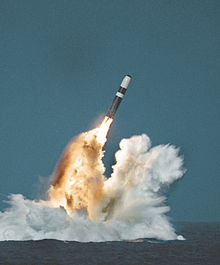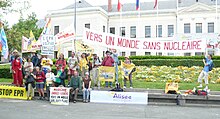Anti-nuclear movement in the United Kingdom: Difference between revisions
format |
→Context: expand |
||
| Line 15: | Line 15: | ||
On 18 October 2010 the British government announced eight locations it considered suitable for future nuclear power stations.<ref>{{cite news|title=Nuclear power: Eight sites identified for future plants|url=http://www.bbc.co.uk/news/uk-politics-11564152|work=BBC News|publisher=BBC|accessdate=18 October 2010|date=18 October 2010}}</ref> This has resulted in public opposition and protests at some of the sites. In March 2012, two of the big six power companies announced they would be pulling out of developing new nuclear power plants. The decision by [[RWE npower]] and [[E.ON]] follows uncertainty over nuclear energy following the Fukushima nuclear disaster last year. The companies will not proceed with their Horizon project, which was to develop nuclear reactors at Wylfa in North Wales and at Oldbury-on-Severn in Gloucestershire. Their decision follows a similar announcement by Scottish and Southern Electricity last year. Analysts said the decision meant the future of UK nuclear power could now be in doubt.<ref>{{cite web |url=http://www.scotsman.com/the-scotsman/scotland/nuclear-disaster-casts-shadow-over-future-of-uk-s-energy-plans-1-2205614 |title=Nuclear disaster casts shadow over future of UK’s energy plans |author=David Maddox |date=30 March 2012 |work=The Scotsman }}</ref> |
On 18 October 2010 the British government announced eight locations it considered suitable for future nuclear power stations.<ref>{{cite news|title=Nuclear power: Eight sites identified for future plants|url=http://www.bbc.co.uk/news/uk-politics-11564152|work=BBC News|publisher=BBC|accessdate=18 October 2010|date=18 October 2010}}</ref> This has resulted in public opposition and protests at some of the sites. In March 2012, two of the big six power companies announced they would be pulling out of developing new nuclear power plants. The decision by [[RWE npower]] and [[E.ON]] follows uncertainty over nuclear energy following the Fukushima nuclear disaster last year. The companies will not proceed with their Horizon project, which was to develop nuclear reactors at Wylfa in North Wales and at Oldbury-on-Severn in Gloucestershire. Their decision follows a similar announcement by Scottish and Southern Electricity last year. Analysts said the decision meant the future of UK nuclear power could now be in doubt.<ref>{{cite web |url=http://www.scotsman.com/the-scotsman/scotland/nuclear-disaster-casts-shadow-over-future-of-uk-s-energy-plans-1-2205614 |title=Nuclear disaster casts shadow over future of UK’s energy plans |author=David Maddox |date=30 March 2012 |work=The Scotsman }}</ref> |
||
In May 2012, a new government report showed that, in England and Wales, hundreds of sites could be contaminated with radioactive waste from old military bases, factories, and old planes. This figure is far higher than previous official estimates.<ref>{{cite web |url=http://www.guardian.co.uk/environment/2012/may/02/radioactive-waste-contaminating-uk-sites |title=Nuclear waste 'may be blighting 1,000 UK sites' |author=Rob Edwards |date=2 May 2012 |work=The Guardian }}</ref> |
|||
==Anti-nuclear protests== |
==Anti-nuclear protests== |
||
Revision as of 00:33, 3 May 2012
The anti-nuclear movement in the United Kingdom consists of groups who oppose nuclear technologies such as nuclear power and nuclear weapons. Many different groups and individuals have been involved in anti-nuclear demonstrations and protests over the years.
One of the most prominent anti-nuclear groups in the UK is the Campaign for Nuclear Disarmament (CND). CND's Aldermaston Marches began in 1958 and continued into the late 1960s when tens of thousands of people took part in the four-day marches. One significant anti-nuclear mobilization in the 1980s was the Greenham Common Women's Peace Camp. In London, in October 1983, more than 300,000 people assembled in Hyde Park as part of the largest protest against nuclear weapons in British history. In 2005 in Britain, there were many protests about the government's proposal to replace the aging Trident weapons system with a newer model.
In October 2010 the British government announced eight locations it considered suitable for future nuclear power stations.[1] This has resulted in public opposition and protests at some of the sites. The Scottish Government, with the backing of the Scottish Parliament, has stated that no new nuclear power stations will be constructed in Scotland.[2][3] In March 2012, RWE npower and E.ON announced they would be pulling out of developing new nuclear power plants. Analysts said the decision meant the future of UK nuclear power could now be in doubt.[4]
Context

There are large variations in peoples’ understanding of the issues surrounding nuclear power, including the technology itself, climate change, and energy security. There is a wide spectrum of views and concerns over nuclear power[5] and it remains a controversial area of public policy.[6] Nuclear power currently provides around 20% of the UK’s electricity.[7]
The UK also has nuclear weapons in the form of Trident missiles which are located on a fleet of submarines, and the funding and deployment of these weapons has also been widely debated.[8][9]
On 18 October 2010 the British government announced eight locations it considered suitable for future nuclear power stations.[10] This has resulted in public opposition and protests at some of the sites. In March 2012, two of the big six power companies announced they would be pulling out of developing new nuclear power plants. The decision by RWE npower and E.ON follows uncertainty over nuclear energy following the Fukushima nuclear disaster last year. The companies will not proceed with their Horizon project, which was to develop nuclear reactors at Wylfa in North Wales and at Oldbury-on-Severn in Gloucestershire. Their decision follows a similar announcement by Scottish and Southern Electricity last year. Analysts said the decision meant the future of UK nuclear power could now be in doubt.[11]
In May 2012, a new government report showed that, in England and Wales, hundreds of sites could be contaminated with radioactive waste from old military bases, factories, and old planes. This figure is far higher than previous official estimates.[12]
Anti-nuclear protests



The first Aldermaston March organised by the Campaign for Nuclear Disarmament took place at Easter 1958, when several thousand people marched for four days from Trafalgar Square, London, to the Atomic Weapons Research Establishment close to Aldermaston in Berkshire, England, to demonstrate their opposition to nuclear weapons.[13][14] The Aldermaston marches continued into the late 1960s when tens of thousands of people took part in the four-day marches.[15]
One significant anti-nuclear mobilization in the 1980s was the Greenham Common Women's Peace Camp. It began in September 1981 after a Welsh group called "Women for Life on Earth" arrived at Greenham to protest against the decision of the Government to allow cruise missiles to be based there.[16] The women's peace camp attracted significant media attention and "prompted the creation of other peace camps at more than a dozen sites in Britain and elsewhere in Europe".[16] In December 1982 some 30,000 women from various peace camps and other peace organisations held a major protest against nuclear weapons on Greenham Common.[17]
On 1 April 1983, about 70,000 people linked arms to form a human chain between three nuclear weapons centres in Berkshire. The anti-nuclear demonstration stretched for 14 miles along the Kennet Valley.[18]
In London, in October 1983, more than 300,000 people assembled in Hyde Park. This was "the largest protest against nuclear weapons in British history", according to the New York Times.[17]
Faslane Naval Base has nuclear capable missiles and is part of the HM Naval Base Clyde in Scotland. Faslane has attracted demonstrations by Campaign for Nuclear Disarmament and Trident Ploughshares. A permanent peace camp is outside the base gates, and there are frequent demonstrations at the base gates. The Scottish National Party, the Scottish Socialist Party and the Scottish Green Party all oppose the deployment of nuclear weapons, and it is not unusual for members of these parties to be present at rallies outside Faslane. Such events aim to keep the base closed for as long as possible by preventing its staff from arriving for work, and usually involve large numbers of protesters being arrested for non-violent civil disobedience.
In 2005 in Britain, there were many protests about the government's proposal to replace the aging Trident weapons system with a newer model. The largest protest had 100,000 participants and, according to polls, 59 percent of the public opposed the move.[19]
In October 2008 in the United Kingdom, more than 30 people were arrested during one of the largest anti-nuclear protests at the Atomic Weapons Establishment at Aldermaston for 10 years. The demonstration marked the start of the UN World Disarmament Week and involved about 400 people.[20]
In October 2011, more than 200 protesters blockaded the Hinkley Point C nuclear power station site. Members of several anti-nuclear groups that are part of the Stop New Nuclear alliance barred access to the site in protest at EDF Energy's plans to renew the site with two new reactors.[21]
In January 2012, three hundred anti-nuclear protestors marched against plans to build a new nuclear power station at Wylfa. The march was organised by Pobl Atal Wylfa B, Greenpeace and Cymdeithas yr Iaith, which are supporting a farmer who is in dispute with Horizon.[22]
In February 2012, protesters set up camp in an abandoned farm on the site of the proposed Hinkley Point C nuclear power station. They are "angry West Somerset Council has given EDF Energy the go-ahead for preparatory work before planning permission has been granted". The group of about seven protesters also claim a nature reserve is at risk from the proposals.[23]
On March 10, 2012, the first anniversary of the Fukushima nuclear disaster, hundreds of anti-nuclear campaigners formed a symbolic chain around Hinkley Point to express their determined opposition to new nuclear power plants, and to call on the coalition government to abandon its plan for seven other new nuclear plants across the UK. Similar protests took place against new nuclear plants at Wylfa in North Wales and Heysham in Lancashire.[24]
Specific groups

One of the most prominent anti-nuclear groups in the UK is the Campaign for Nuclear Disarmament (CND). CND favours nuclear disarmament by all countries and tighter international regulation through treaties such as the Nuclear Non-Proliferation Treaty. CND is also opposed to any new nuclear power stations being built in the United Kingdom. One of the activities most strongly associated with CND is the Aldermaston Marches. Other anti-nuclear groups in the UK include:
|
|
Public opinion
A large nationally representative 2010 British survey about energy issues found that public opinion is divided on the issue of nuclear power. The majority of people are concerned about nuclear power and public trust in the government and nuclear industry remains relatively low. The survey showed that there is a clear preference for renewable energy sources over nuclear power.[35]
According to a national opinion poll, support for nuclear power in the UK dropped by twelve percent following the Fukushima Daiichi nuclear disaster.[36]
As of 2011, the government's programme to build new nuclear power stations in England will be "delayed by at least three months so that lessons can be learned from the accident at Fukushima in Japan".[37][38]
Academics
In 2008, several prominent UK academics spoke out against the government's proposal to build a new generation of nuclear power plants:[39][40]
- Frank Barnaby
- Paul Dorfman[41]
- David Elliott (professor)
- Kate Hudson (activist)
- Jerome Ravetz
- Andy Stirling
- Stephen Thomas (professor)
- Gordon Walker (professor)
Other individuals
See also
References
- ^ "Nuclear power: Eight sites identified for future plants". BBC News. BBC. 18 October 2010. Retrieved 18 October 2010.
- ^ "Answers to your questions on energy in Scotland". The Scottish Government. Retrieved 5 May 2011.
- ^ "Official Report 17 January 2008". The Scottish Parliament. Retrieved 5 May 2011.
- ^ David Maddox (30 March 2012). "Nuclear disaster casts shadow over future of UK's energy plans". The Scotsman.
- ^ Sustainable Development Commission. Public engagement and nuclear power
- ^ Sustainable Development Commission. Is Nuclear the Answer? p. 12.
- ^ Sustainable Development Commission. The Role of Nuclear Power in a Low Carbon Economy p. 1.
- ^ UK nuclear weapons plan unveiled BBC News, 4 December 2006.
- ^ Helen Pidd. Trident nuclear missiles are £20bn waste of money, say generals The Guardian, 16 January 2009.
- ^ "Nuclear power: Eight sites identified for future plants". BBC News. BBC. 18 October 2010. Retrieved 18 October 2010.
- ^ David Maddox (30 March 2012). "Nuclear disaster casts shadow over future of UK's energy plans". The Scotsman.
- ^ Rob Edwards (2 May 2012). "Nuclear waste 'may be blighting 1,000 UK sites'". The Guardian.
- ^ Campaign for Nuclear Disarmament. The history of CND
- ^ "Early defections in march to Aldermaston". Guardian Unlimited. 1958-04-05.
- ^ Jim Falk (1982). Global Fission: The Battle Over Nuclear Power, Oxford University Press, pp. 96-97.
- ^ a b David Cortright (2008). Peace: A History of Movements and Ideas, Cambridge University Press, p. 147.
- ^ a b David Cortright (2008). Peace: A History of Movements and Ideas, Cambridge University Press, p. 148.
- ^ Paul Brown, Shyama Perera and Martin Wainwright. Protest by CND stretches 14 miles The Guardian, 2 April 1983.
- ^ Lawrence S. Wittner. A rebirth of the anti-nuclear weapons movement? Portents of an anti-nuclear upsurge Bulletin of the Atomic Scientists, 7 December 2007.
- ^ More than 30 arrests at Aldermaston anti-nuclear protest The Guardian, 28 October 2008.
- ^ "Hinkley Point power station blockaded by anti-nuclear protesters". The Guardian. 3 October 2011.
- ^ Elgan Hearn (January 25, 2012). "Hundreds protest against nuclear power station plans". Online Mail.
- ^ "Anti-nuclear campaigners set up camp at Hinkley C site". BBC News. 12 February 2012.
- ^ "Brits protest against govt. nuclear plans". PressTV. Mar 10, 2012.
- ^ CANSAR
- ^ Low Level Radiation Campaign
- ^ News and information about the UK nuclear industry
- ^ No new nukes!
- ^ Welcome to Nuclear Pledge
- ^ Shutdown Sizewell Campaign
- ^ Nuclear incident only avoided by eagle-eyed contractor
- ^ Stop Hinkley
- ^ Anti-nuclear groups fear danger at new reactor
- ^ Nuclear is too little, too late and too dangerous
- ^ Spence, Alexa et al. (2010). Public Perceptions of Climate Change and Energy Futures in Britain School of Psychology, Cardiff University.
- ^ Bibi van der Zee (22 March 2011). "Japan nuclear crisis puts UK public off new power stations". The Guardian.
- ^ Rob Edwards (5 April 2011). "UK nuclear plans on hold after Fukushima". The Guardian.
- ^ Kari Lundgren (July 28, 2011). "Centrica Says Nuclear Plants Likely Delayed, Slows Spending". Bloomberg Businessweek.
- ^ Scientists take on Brown over nuclear plans
- ^ Nuclear Consultation: Public Trust in Government
- ^ Paul Dorfman. Power Trip The Guardian, 23 May 2007.
- ^ Fears over nuclear waste transport plan
- ^ Jon Kelly. Nuclear veterans vow to fight on BBC News, 10 January 2008.
External links
- Nuclear veterans vow to fight on
- Arrests at anti-nuclear protest
- Malvern GP arrested at anti-nuclear protest
- MSP arrested in anti-nuclear demo
- Govt's nuclear programme will be a 'financial disaster'
- The anti-nuclear movement can achieve change
- Anti-nuclear protest at dockyard
- Hundreds protest at nuclear site
- Concerns over proposed nuclear power station for Anglesey
- Peace group remembers Chernobyl nuclear disaster

